|
Neolithic Settlement Vráble
The Linear Pottery settlement Vráble-Veľké Lehemby is a significant archaeological site from the early Neolithic in southwestern Slovakia. It stands out from many other settlements of the Linear Pottery Culture due to several unique features, including the size of the settlement, the structure surrounded by a ditch, and the discovery of a mass grave containing numerous decapitated individuals. The settlement was discovered in 2009 and has been systematically excavated since 2012 by an international research team led by the Academy of Sciences in Nitra and by researchers from the Collaborative Research Centre 1266 at Kiel University. Location and settlement structure The Vráble-Veľké Lehemby settlement consists of three clusters of houses. A total of 313 longhouses have been reconstructed, built over a period of about 200 to 300 years (c. 5250–5000 BCE). The overlapping of houses suggests that only a few houses existed at the same time. The settlement is particularly kno ... [...More Info...] [...Related Items...] OR: [Wikipedia] [Google] [Baidu] |
Linear Pottery Culture
The Linear Pottery culture (LBK) is a major archaeological horizon of the European Neolithic period, flourishing . Derived from the German ''Linearbandkeramik'', it is also known as the Linear Band Ware, Linear Ware, Linear Ceramics or Incised Ware culture, falling within the Danubian I culture of V. Gordon Childe. Most cultural evidence has been found on the middle Danube, the upper and middle Elbe, and the upper and middle Rhine. It represents a major event in the initial spread of agriculture in Europe. The pottery consists of simple cups, bowls, vases, jugs without handles and, in a later phase, with pierced lugs, bases, and necks.Hibben, page 121. Important sites include Vráble and Nitra in Slovakia; Bylany in the Czech Republic; Langweiler and Zwenkau (Eythra) in Germany; Brunn am Gebirge in Austria; Elsloo, Sittard, Köln-Lindenthal, Aldenhoven, Flomborn, and Rixheim on the Rhine; Lautereck and Hienheim on the upper Danube; and Rössen and Sond ... [...More Info...] [...Related Items...] OR: [Wikipedia] [Google] [Baidu] |
Vráble
Vráble is a small town in the Nitra District, Nitra Region, western Slovakia. Etymology The name derives from ''vrábeľ'' - a Slovak dialect name of sparrow (''vrabec''). Geography It is located in the Danubian Hills on the Žitava river, about south-east-east from Nitra. The cadastral area of the town has an altitude from ASL. There's a small dam called ''Vodná nádrž Vráble'' west of the town. The town has three parts: Vráble proper, and the former villages of Dyčka and Horný Ohaj (both annexed 1975). History The oldest evidence of the settlement of Vráble comes from the Neolithic age (6000-2000 BC). The first written reference is from 1265 as ''Verebel''. In Vráble, there was the oldest post-station. The city kept an agricultural character in the 19th and 20th centuries. Economic development has influenced the architecture of the city. Before the establishment of independent Czechoslovakia in 1918, Vráble was part of Bars County within the Kingdom of Hungar ... [...More Info...] [...Related Items...] OR: [Wikipedia] [Google] [Baidu] |
Neolithic
The Neolithic or New Stone Age (from Ancient Greek, Greek 'new' and 'stone') is an archaeological period, the final division of the Stone Age in Mesopotamia, Asia, Europe and Africa (c. 10,000 BCE to c. 2,000 BCE). It saw the Neolithic Revolution, a wide-ranging set of developments that appear to have arisen independently in several parts of the world. This "Neolithic package" included the History of agriculture, introduction of farming, domestication of animals, and change from a hunter-gatherer lifestyle to one of sedentism, settlement. The term 'Neolithic' was coined by John Lubbock, 1st Baron Avebury, Sir John Lubbock in 1865 as a refinement of the three-age system. The Neolithic began about 12,000 years ago, when farming appeared in the Epipalaeolithic Near East and Mesopotamia, and later in other parts of the world. It lasted in the Near East until the transitional period of the Chalcolithic (Copper Age) from about 6,500 years ago (4500 BCE), marked by the development ... [...More Info...] [...Related Items...] OR: [Wikipedia] [Google] [Baidu] |
Collaborative Research Centre 1266
Collaboration (from Latin ''com-'' "with" + ''laborare'' "to labor", "to work") is the process of two or more people, entities or organizations working together to complete a task or achieve a goal. Collaboration is similar to cooperation. The form of leadership can be social within a decentralized and egalitarian group.Spence, Muneera U. ''"Graphic Design: Collaborative Processes = Understanding Self and Others."'' (lecture) Art 325: Collaborative Processes. Fairbanks Hall, Oregon State University, Corvallis, Oregon. 13 April 2006See also. Teams that work collaboratively often access greater resources, recognition and rewards when facing competition for finite resources. Caroline S. Wagner and Loet Leydesdorff. Globalisation in the network of science in 2005: The diffusion of international collaboration and the formation of a core group.'' Structured methods of collaboration encourage introspection of behavior and communication. Such methods aim to increase the success of teams ... [...More Info...] [...Related Items...] OR: [Wikipedia] [Google] [Baidu] |
Kiel University
Kiel University, officially the Christian Albrecht University of Kiel, (, abbreviated CAU, known informally as Christiana Albertina) is a public University, public research university in the city of Kiel, Germany. It was founded in 1665 as the ''Academia Holsatorum Chiloniensis'' by Christian Albert, Duke of Holstein-Gottorp and has approximately 27,000 students today. It is the largest, oldest, and most prestigious university in the state of Schleswig-Holstein. Until 1866, it was not only the northernmost university in Germany but at the same time the 2nd largest university of Denmark. Faculty, alumni, and researchers of Kiel University have won 12 Nobel Prizes. Kiel University has been a member of the German Universities Excellence Initiative since 2006. The Cluster of Excellence The Future Ocean, which was established in cooperation with the GEOMAR Helmholtz Centre for Ocean Research Kiel in 2006, is internationally recognized. The second Cluster of Excellence "Inflammation a ... [...More Info...] [...Related Items...] OR: [Wikipedia] [Google] [Baidu] |
Spondylus
''Spondylus'' is a genus of bivalve molluscs, the only genus in the family Spondylidae and subfamily Spondylinae. They are known in English as spiny oysters or thorny oysters (although they are not, in fact, true oysters, but are related to scallops). Description The many species of ''Spondylus'' vary considerably in appearance. They are grouped in the same superfamily as the scallops. They are not closely related to true oysters (family Ostreidae); however, they do share some habits such as cementing themselves to rocks rather than attaching themselves by a byssus. The two halves of their shells are joined with a ball-and-socket type of hinge, rather than with a toothed hinge as is more common in other bivalves. They also still retain vestigial anterior and posterior ''auricles'' ("ears", triangular shell flaps) along the hinge line, a characteristic feature of scallops, although not of oysters. As is the case in all scallops, ''Spondylus'' spp. have multiple eyes around ... [...More Info...] [...Related Items...] OR: [Wikipedia] [Google] [Baidu] |
Želiezovce Group
The Želiezovce group was an archaeological group ("archaeological culture, culture") during the first part of the Middle Neolithic period in western Slovakia, Spiš, Transdanubia, adjacent Austria, southern Moravia, and southern and south-eastern Poland. It arose from the Linear Pottery Culture. The group is named after finds made in Veľký Pesek, now part of the village of Sikenica (which was part of Želiezovce in 1986-1992). The Excavation (archaeology), excavation archive was deposited in Želiezovce when discovered. References Archaeological cultures in Austria Archaeological cultures in the Czech Republic Archaeological cultures in Hungary Archaeological cultures in Poland Archaeological cultures in Slovakia Neolithic cultures of Europe {{europe-archaeology-stub ... [...More Info...] [...Related Items...] OR: [Wikipedia] [Google] [Baidu] |
Lengyel Culture
__NOTOC__ The Lengyel culture is an archaeological culture of the European Neolithic, centered on the Middle Danube in Central Europe. It flourished from 5000 to 4000 BC, ending with phase IV, e.g., in Bohemia represented by the ' Jordanow/Jordansmühler culture'. It is followed by the Funnelbeaker culture/TrB culture and the Baden culture. The eponymous type site is at Lengyel in Tolna county, Hungary. It was preceded by the Linear Pottery culture and succeeded by the Corded Ware culture. In its northern extent, overlapped the somewhat later but otherwise approximately contemporaneous Funnelbeaker culture. Also closely related are the Stroke-ornamented ware and Rössen cultures, adjacent to the north and west, respectively. Subgroups of the Lengyel horizon include the Austrian/Moravian Painted Ware I and II, Aichbühl, Jordanów/Jordanov/Jordansmühl, Schussenried, Gatersleben, etc. It is a wide interaction sphere or cultural horizon rather than an archaeological culture i ... [...More Info...] [...Related Items...] OR: [Wikipedia] [Google] [Baidu] |
Bükk Culture
The Bükk Mountains () are a section of the North Hungarian Mountains of the Inner Western Carpathians. Much of the area is included in the Bükk National Park. Geography Although Kékes, the highest point in Hungary, is not here but in the nearby Mátra Mountains, the average height of the Bükk Mountains–with more than 20 peaks higher than 900 m–exceeds that of Mátra. The highest point of Bükk is Kettős bérc (961 m), the third highest main peak in Hungary after Kékes and Galyatető. There are 1,115You can find information about Hungarian caves here: known caves in the mountain range, including Bányász-barlang (Miner cave, 274 m) and István-lápa (254 m), the deepest caves in Hungary, the archaeologically important Szeleta cave, the Cave Bath (a main tourist attraction of Miskolc-Tapolca), the Anna Cave, and the István Cave. 52 of the caves are protected because of their fauna and microclimate. The mountain range is also famous for its skiing faci ... [...More Info...] [...Related Items...] OR: [Wikipedia] [Google] [Baidu] |
Vráble 2
Vráble is a small town in the Nitra District, Nitra Region, western Slovakia. Etymology The name derives from ''vrábeľ'' - a Slovak dialect name of sparrow (''vrabec''). Geography It is located in the Danubian Hills on the Žitava river, about south-east-east from Nitra. The cadastral area of the town has an altitude from ASL. There's a small dam called ''Vodná nádrž Vráble'' west of the town. The town has three parts: Vráble proper, and the former villages of Dyčka and Horný Ohaj (both annexed 1975). History The oldest evidence of the settlement of Vráble comes from the Neolithic age (6000-2000 BC). The first written reference is from 1265 as ''Verebel''. In Vráble, there was the oldest post-station. The city kept an agricultural character in the 19th and 20th centuries. Economic development has influenced the architecture of the city. Before the establishment of independent Czechoslovakia in 1918, Vráble was part of Bars County within the Kingdom of Hungar ... [...More Info...] [...Related Items...] OR: [Wikipedia] [Google] [Baidu] |
Pseudoneglect
The term pseudoneglect refers to the natural tendency of shifting spatial attention to the left. The concept was introduced and evidenced by experimental findings regarding the line bisection task. In this task, participants are supposed to mark the middle of a horizontal line. On average, their deviations from the actual center of the line tend to be more to the left than to the right. In other visuo-spatial tasks, a similar bias to the left hemifield is apparent. Pseudoneglect shows similarities to impairments in patients with a medial condition called hemispatial neglect. However, the effects of pseudoneglect are marginal and mainly restricted to experimental settings in scientific labs. In 2020, archaeologists of the Collaborative Research Center CRC 1266 at Kiel University succeeded in proving this behavior in prehistory. In the Linear Pottery, so-called long houses were built. In the Neolithic settlement of Vráble, in the southwest of Slovakia, three comparatively large se ... [...More Info...] [...Related Items...] OR: [Wikipedia] [Google] [Baidu] |





